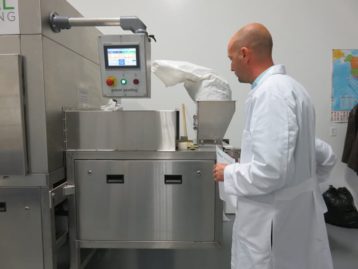- Phone: 306-970-1552
- connect@gentleprocessing.ca
- 18-301 South Industrial Dr. Prince Albert, SK S6V 7L7, Canada

For most people, the origin of their food is a complex mystery. Consumers in the developed world are satisfied with the labels and packaging they see in supermarkets, never digging deeper to see if the food they consume is actually the best for their health and well being.
The process by which food is processed has a fundamental impact on the nutrient content, shelf life, and taste profile of every item in the grocery aisle. A number of these items are processed through high pressure and pulsed electric fields. Although these techniques can eliminate bacteria and improve the shelf-life of foods, they lower the nutrients and taste profile. An innovative new technique known as Gentle Processing™ promises to mitigate perishability without compromising the quality of what consumers eat.
Here are some of the key differences between the traditional food processing techniques and the relatively new Gentle Processing™ method:
The high pressure food processing technique or HPP involves subjecting packaged food to high pressures at ambient or lower than ambient temperatures. This immense pressure can eliminate microorganisms within the food depending on the texture of the food, the ambient temperature, and the duration of applied pressure.
HPP is generally used to press fruit juice, but experts argue that the process has an impact on the plants and fruits on a cellular level. The cell structure is irreversibly altered by the intense pressures, making the processed food less natural or raw. HPP is also ineffective at eradicating spore-forming organisms. Some low-acid food organisms like Clostridium botulinum generate spores that are highly toxic.
Pulse electric field (PEF) food processing technique, on the other hand, exposes the food items to electric fields for prolonged durations. The field strength is adjusted so that microorganisms and bacteria living within the food are killed, but the cells of the plant are unaffected.
There are a number of disadvantages of the PEF food processing technique. The process is highly capital intensive and requires constant operation. PEF is ineffective at deactivating enzymes in food or eliminating spore-forming organisms. The process is best suited to solid foods without air bubbles or electrical conductivity. The process cannot increase the shelf life of foods without the need for refrigeration.
These disadvantages have prevented both HPP and PEF from widespread adoption in the food industry.
The highly-engineered Gentle Processing™ technology targets water molecules within food to generate heat from within the item. Gentle Processing involves targeting energy on water molecules within the food to heat it from within. With an even heating process, the food can be processed quickly, cheaply, and more organically, while preserving the natural flavors and nutrients. This innovative technique results in the elimination of bacteria spores, microorganisms, and the cysts of pests through evenly distributed energy.
Unlike other food processing techniques, Gentle Processing™ is a more promising technology. Not only is Gentle Processing a more natural approach, but the effects are deeper, the process is cost-effective, and the quality of food is better preserved.
Gentle Processing™ applies evenly distributed heat to the food item. Unlike HPP, this food processing technique can eliminate bacterial spores and even deactivate enzymes. The process is applicable to a wider range of food items. Unlike PEF, Gentle Processing™ can also target non-vegetative bacteria living in different forms of food. The cost of operating a Gentle Processing™ plant are orders of magnitude cheaper than PEF or HPP.
As a comparatively natural food processing technique, Gentle Processing can secure the nutrients and taste profile of food. The shelf-life is extended without compromising on the wholesomeness of the product.
Not only is Gentle Processing™ more flexible and efficient, but it is also more cost-effective. Unlike other emerging technologies in the food industry, Gentle Processing™ is more organic, utilizing pure energy to heat the food from within. This simple technique works for a broader range of food items and has a reduced impact on the flavor profiles and nutrient content of food when compared to PEF or HPP food processing techniques.